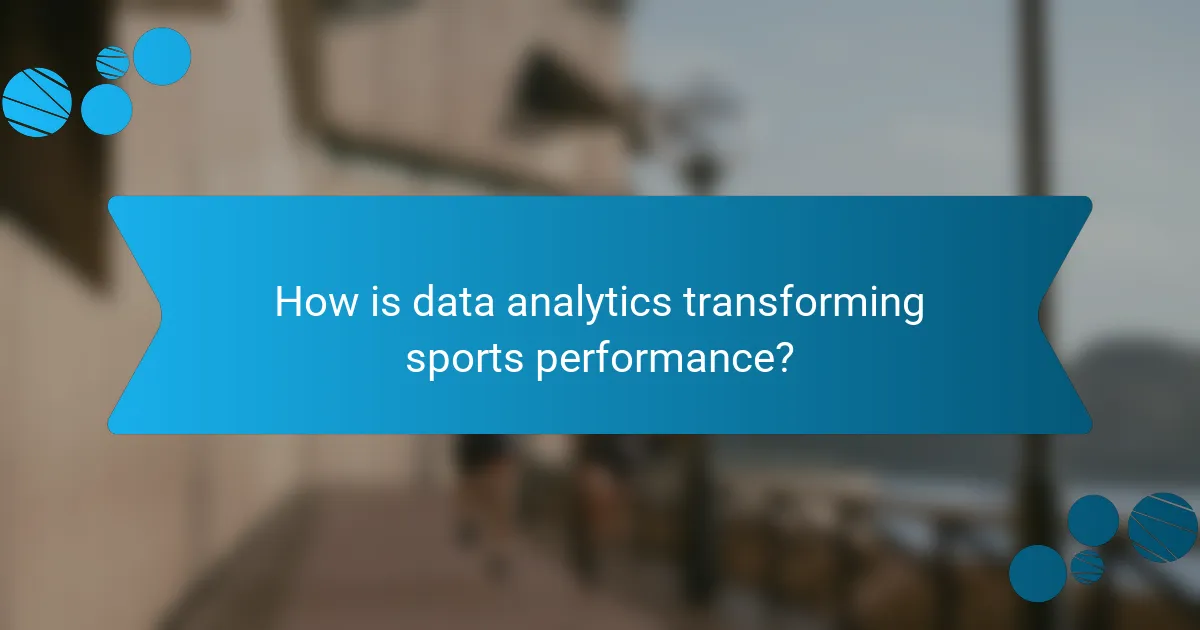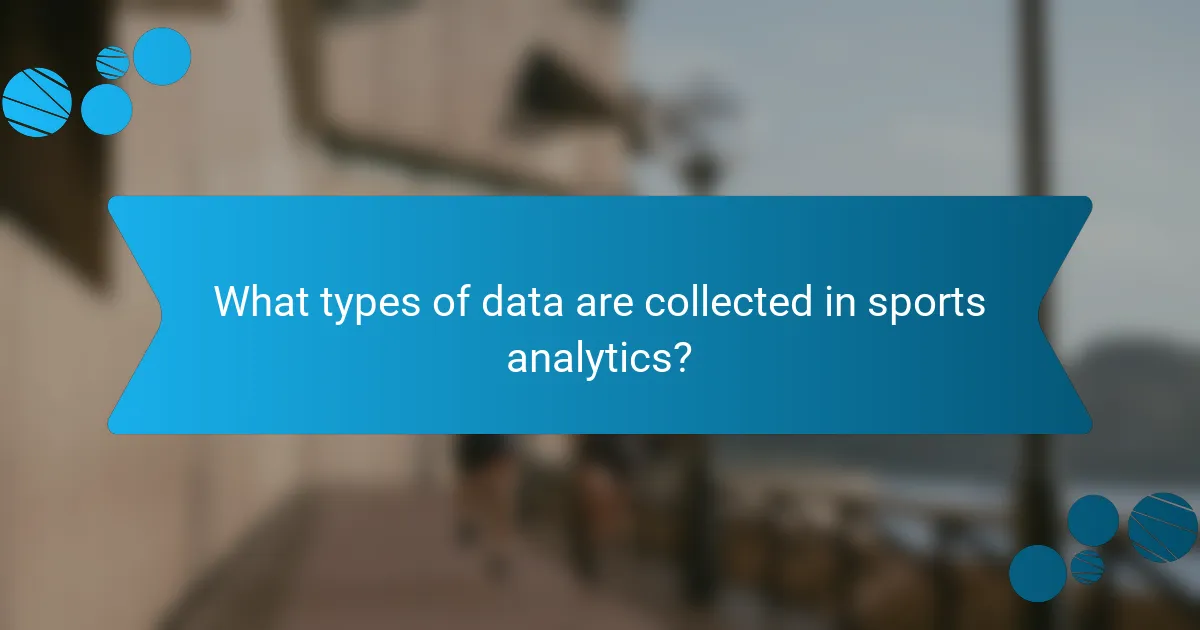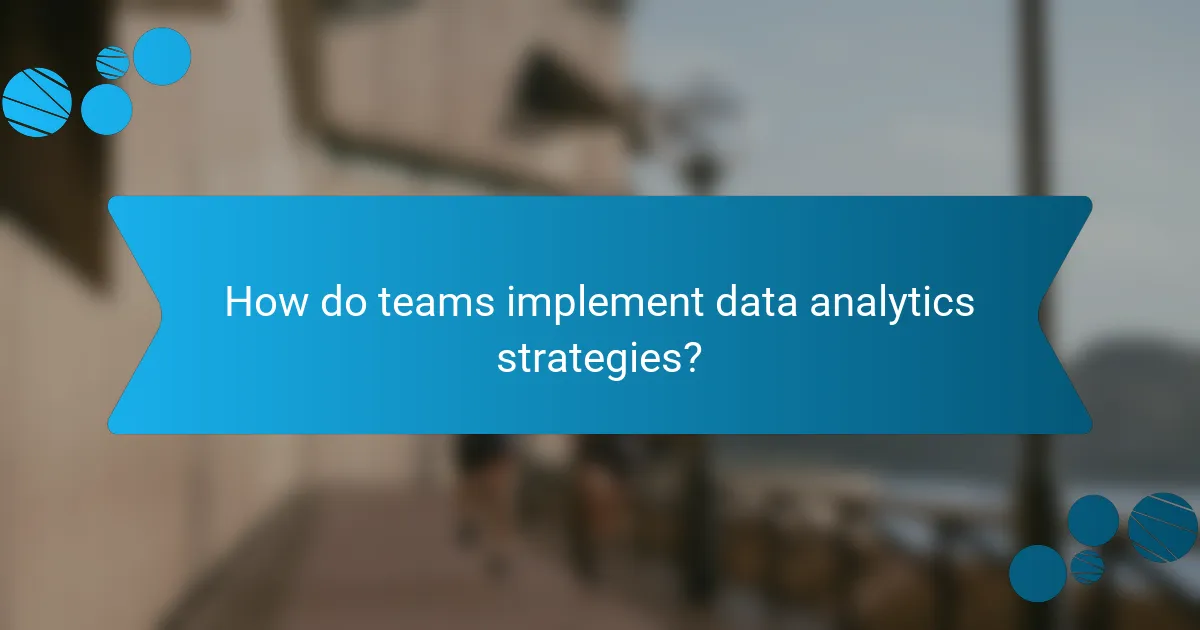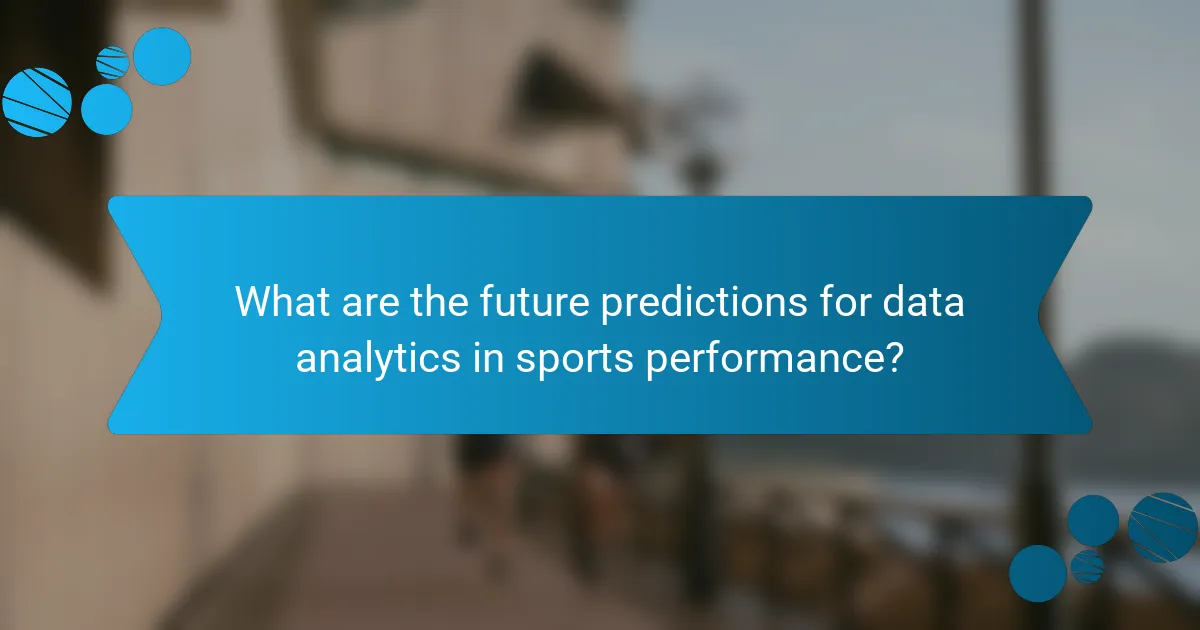Data analytics is transforming sports performance by providing insights that enhance training and competition strategies. Key applications include player tracking technology, video analysis, and the integration of various data types. Emerging trends like machine learning and real-time performance tracking are shaping future strategies. Ethical considerations ensure data privacy and fairness in competitive environments.

How is data analytics transforming sports performance?
Data analytics is revolutionising sports performance by providing actionable insights that enhance training and competition strategies. Coaches and athletes leverage data to analyse performance metrics, optimise training regimens, and improve game strategies.
One significant application is player tracking technology, which collects data on speed, movement patterns, and fatigue levels. This information allows teams to tailor training programmes to individual needs, enhancing athlete performance and reducing injury risks. For example, the use of wearable devices has shown a 30% decrease in injury rates among professional athletes.
Another trend is the integration of video analysis with data analytics. Coaches can assess player decisions and movements in real-time, leading to more effective tactical adjustments during games. This combination of visual and statistical data supports a deeper understanding of gameplay dynamics.
As a result, data analytics is not just a tool but a transformative force in sports, driving innovation and competitive advantage across various athletic disciplines.
What are the key benefits of using data analytics in sports?
Data analytics in sports enhances performance, optimises strategies, and improves decision-making. Key benefits include injury prevention through predictive modelling, performance enhancement via data-driven insights, and fan engagement through personalised experiences. Additionally, analytics support talent scouting by identifying potential players based on performance metrics. As a result, teams can gain a competitive edge by leveraging data for strategic advantages.
Which sports are leading in data analytics adoption?
Basketball, football, and baseball are leading in data analytics adoption. These sports leverage analytics for performance optimisation, injury prevention, and strategic decision-making.
Basketball teams use player tracking data to analyse shooting efficiency and defensive matchups. Football relies on analytics for play calling and player evaluations. Baseball employs sabermetrics to assess player performance and game strategies.
Emerging sports like esports are also adopting analytics, focusing on player behaviour and game dynamics. This trend highlights the increasing importance of data-driven insights across various sports disciplines.
How do athletes utilise data analytics for performance improvement?
Athletes utilise data analytics to enhance performance by analysing metrics, identifying strengths, and optimising training regimens. They leverage wearable technology to track physiological data and performance statistics. This data informs coaching strategies and athlete conditioning, leading to improved outcomes.
Data analytics also allows for real-time feedback, enabling athletes to make immediate adjustments during training and competitions. For instance, analysing movement patterns can help prevent injuries, enhancing athlete longevity. Advanced analytics tools, such as machine learning algorithms, predict performance trends and tailor individualised training programmes.
Furthermore, teams use data analytics for strategic planning, assessing opponents’ weaknesses, and developing game strategies. By integrating data-driven insights, athletes can maximise their potential and achieve peak performance.

What types of data are collected in sports analytics?
Sports analytics collects various types of data to evaluate performance. Key categories include player statistics, game metrics, biometric data, and environmental factors.
Player statistics encompass individual performance metrics like points scored, assists, and rebounds. Game metrics analyse team performance, including possession time and shooting accuracy. Biometric data tracks player health indicators such as heart rate and fatigue levels. Environmental factors consider conditions like temperature and humidity that may impact performance.
These data types provide insights that enhance training, strategy, and overall team performance.
How is biometric data used to enhance athletic performance?
Biometric data enhances athletic performance by providing real-time insights into an athlete’s physiological state. It allows for personalised training regimens, optimising recovery, and improving overall performance metrics.
Athletes utilise wearable devices to track heart rate, oxygen levels, and sleep patterns. This data enables coaches to make informed decisions on training intensity and recovery protocols. For instance, monitoring heart rate variability can indicate stress levels, guiding adjustments in training loads.
Recent trends show that integrating biometric data with machine learning algorithms enhances predictive analytics. This approach can forecast injury risks, allowing for preemptive measures. Additionally, athletes can analyse performance trends over time, identifying areas for improvement.
Overall, the use of biometric data in sports performance is transforming training methodologies, ensuring athletes reach their peak potential while minimising injury risks.
What role does performance tracking technology play in data collection?
Performance tracking technology is essential for data collection in sports analytics. It enables real-time monitoring of athletes’ performance metrics, enhancing decision-making and strategic planning. This technology captures data such as speed, heart rate, and movement patterns, providing valuable insights into training effectiveness and injury prevention. Moreover, advanced analytics can identify trends in athlete performance over time, helping coaches tailor training programmes to individual needs. The integration of wearable devices and software solutions has transformed performance tracking into a vital component of modern sports management.
Which data visualisation tools are most effective in sports analytics?
The most effective data visualisation tools in sports analytics include Tableau, Power BI, and R. These tools provide powerful capabilities for analysing performance data and visualising trends.
Tableau excels in creating interactive dashboards, making it user-friendly for sports teams to explore data insights. Power BI integrates seamlessly with Microsoft products, offering robust data modelling features. R, with its extensive libraries, allows for custom visualisations tailored to specific sports analytics needs.
Each tool has unique attributes that cater to different aspects of data visualisation, such as real-time analytics and predictive modelling, enhancing decision-making in sports performance.

How do teams implement data analytics strategies?
Teams implement data analytics strategies by integrating data collection, analysis, and application into their workflows. They begin by identifying key performance indicators relevant to their objectives. Data is gathered from various sources, including player statistics, game footage, and training metrics. Advanced analytics tools are then employed to interpret this data, revealing insights that inform decision-making. Collaboration among coaching staff, analysts, and players ensures that these insights are applied effectively in training and game strategies. Continuous evaluation of analytics outcomes allows teams to refine their strategies over time.
What are the common challenges faced during implementation?
Implementing data analytics in sports performance often faces challenges like data quality issues, integration difficulties, and resistance to change. These obstacles can hinder effective decision-making and performance improvement.
Data quality issues arise from inconsistent or incomplete data collection methods. Integration difficulties occur when combining data from various sources, leading to compatibility problems. Resistance to change is common among stakeholders who may be hesitant to adopt new technologies or processes.
Additionally, a lack of skilled personnel can impede the successful implementation of analytics. Organisations may struggle to find professionals who can interpret data effectively and translate insights into actionable strategies.
How do coaching staff adapt to data-driven insights?
Coaching staff adapt to data-driven insights by integrating analytics into training and game strategies. They utilise performance metrics to enhance player development and optimise team tactics. This approach allows for real-time adjustments during games, improving decision-making. For example, video analysis combined with statistical data helps identify strengths and weaknesses, leading to tailored coaching methods.
What are the best practices for integrating analytics into training programmes?
Integrating analytics into training programmes enhances performance and decision-making. Focus on data collection, analysis, and actionable insights.
1. Establish clear objectives for analytics use.
2. Utilise real-time data to monitor athlete performance.
3. Incorporate feedback loops for continuous improvement.
4. Train staff on data interpretation and application.
5. Foster a culture that values data-driven decisions.

Which emerging trends are shaping the future of sports analytics?
Emerging trends shaping the future of sports analytics include advanced data integration, machine learning applications, and real-time performance tracking. These trends enhance decision-making and player performance evaluation.
Advanced data integration allows teams to combine various data sources, providing a comprehensive view of player metrics. Machine learning applications help in predicting outcomes based on historical performance data. Real-time performance tracking utilises wearable technology, offering immediate insights into athlete capabilities.
These innovations enable teams to optimise training regimens and improve game strategies, ultimately enhancing competitive advantage. As a result, the sports analytics landscape continues to evolve, driven by technological advancements and data-driven insights.
How is artificial intelligence influencing sports performance analysis?
Artificial intelligence significantly enhances sports performance analysis by providing data-driven insights. AI processes vast amounts of performance data, enabling coaches and athletes to identify strengths and weaknesses. For example, machine learning algorithms analyse player movements, optimising training regimens. This technology also predicts injury risks by assessing biomechanical data, allowing for preventative measures. Furthermore, AI facilitates real-time analytics during games, improving tactical decisions. Overall, AI’s integration into sports analytics transforms performance evaluation and strategy development.
What impact do wearables have on data collection and analysis?
Wearables significantly enhance data collection and analysis in sports performance. They provide real-time metrics on athletes’ biometrics, movement patterns, and training loads. This data allows for personalised training regimens and performance optimisation.
Wearables collect various data points, such as heart rate, sleep quality, and activity levels. This information enables coaches and athletes to identify trends and make informed decisions. As a result, teams can tailor strategies to improve performance and reduce injury risks.
The integration of wearables with advanced analytics platforms allows for deeper insights. Machine learning algorithms can analyse large datasets to uncover patterns that human analysis might miss. This capability leads to a competitive edge in sports performance.
In summary, wearables transform data collection and analysis by providing valuable insights that enhance training effectiveness and athletic performance. Their continuous evolution promises even greater advancements in the future.
How are fan engagement and data analytics intersecting?
Fan engagement and data analytics intersect by leveraging insights to enhance the fan experience. Sports organisations analyse fan behaviour and preferences to tailor marketing strategies, improve game-day experiences, and foster community engagement. For instance, data analytics can identify trends in ticket sales, merchandise purchases, and social media interactions, allowing teams to personalise content and offers. This targeted approach increases fan loyalty and satisfaction, ultimately driving revenue growth. As a result, the integration of data analytics into fan engagement strategies is becoming essential for modern sports organisations.

What ethical considerations arise with data analytics in sports?
Ethical considerations in data analytics for sports include privacy, consent, and fairness. Athletes’ personal data must be protected to prevent misuse. Ensuring informed consent is crucial when collecting performance data. Additionally, analytics should not reinforce biases or create unfair advantages among competitors. Transparency in data usage fosters trust and accountability in sports organisations.
How is athlete privacy maintained in data collection?
Athlete privacy in data collection is maintained through stringent regulations and anonymisation techniques. Organisations implement data protection policies to ensure personal information is secure. Consent is obtained from athletes before collecting sensitive data. Additionally, data is often aggregated to prevent identification of individuals. This approach balances performance insights with respect for athlete privacy.
What are the implications of data misuse in sports analytics?
Data misuse in sports analytics can lead to significant consequences, including compromised athlete privacy and skewed performance evaluations. Inaccurate data can misinform coaching strategies, leading to poor decision-making. Furthermore, misuse can damage the integrity of competitions, eroding trust among stakeholders. As a result, organisations must prioritise ethical data practices to ensure fair play and accurate insights.

What are the unique case studies of successful data analytics applications in sports?
Data analytics has transformed sports performance through unique applications. Notable case studies include the use of wearable technology by the NBA’s Golden State Warriors, which tracks player movements to optimise training and prevent injuries. In football, FC Barcelona employs data analytics for player recruitment and match strategy, enhancing team performance. The NFL’s New England Patriots utilise analytics to analyse opponent tendencies, improving game planning. Finally, Major League Baseball’s Houston Astros apply predictive analytics for player performance evaluation, leading to strategic roster decisions. These examples illustrate the diverse applications of data analytics in enhancing athletic performance and decision-making.
How did a specific team improve their performance through data analytics?
A specific team improved their performance through data analytics by leveraging player performance metrics and game strategy insights. They utilised advanced statistics to identify strengths and weaknesses, enabling targeted training and strategic adjustments. This data-driven approach led to a measurable increase in win rates and player efficiency. For example, the integration of real-time analytics during games allowed coaches to make informed decisions, enhancing overall team dynamics and performance outcomes.
What lessons can be learned from failures in sports analytics implementation?
Failures in sports analytics implementation highlight critical lessons for future success. Key takeaways include the importance of aligning analytics with team goals, ensuring data quality, and fostering a culture of collaboration among stakeholders.
Misalignment between analytics and strategic objectives often leads to wasted resources. For instance, if a team focuses on player performance metrics but neglects injury prevention data, it may miss opportunities for improvement. Additionally, poor data quality can result in misleading insights, leading teams to make uninformed decisions.
Collaboration across departments is essential for effective implementation. When coaches, analysts, and players work together, they can better interpret data and apply insights in practice. This synergy can enhance performance outcomes and drive team success.
Ultimately, learning from past failures enables organisations to refine their analytics strategies. By prioritising alignment, data integrity, and collaboration, teams can leverage analytics to gain a competitive edge in sports performance.

What are the future predictions for data analytics in sports performance?
Data analytics in sports performance is expected to evolve significantly, enhancing athlete training and game strategies. Future predictions include increased use of artificial intelligence for real-time data analysis, personalised training programmes, and injury prevention strategies. Wearable technology will provide more accurate performance metrics, while data visualisation tools will improve decision-making processes for coaches and athletes. Additionally, integrating fan engagement analytics will enhance viewer experiences and team marketing strategies.
How will data analytics evolve in the next five years?
Data analytics in sports performance will evolve significantly over the next five years through advanced technologies and methodologies. Enhanced machine learning algorithms will provide deeper insights into athlete performance, injury prevention, and game strategy. Real-time data collection will become more sophisticated, allowing coaches to make informed decisions during competitions. Further, the integration of wearable technology will enable personalised training regimens based on individual athlete data. The emphasis on data-driven decision-making will increase, fostering a culture of continuous improvement in sports teams.
What skills will be essential for professionals in sports analytics?
Professionals in sports analytics must develop skills in data interpretation, statistical analysis, programming, and visualisation. Strong knowledge of sports science and the ability to communicate findings effectively are also essential. These skills enable analysts to derive actionable insights from performance data, improving team strategies and player development.
What practical tips can athletes and coaches use to leverage data analytics effectively?
Athletes and coaches can leverage data analytics effectively by focusing on specific strategies. First, establish clear performance metrics to track progress. Second, utilise wearable technology to gather real-time data during training and competitions. Third, analyse historical performance data to identify trends and areas for improvement. Fourth, incorporate video analysis to enhance technique and decision-making. Finally, foster a culture of data-driven decision-making within the team to maximise insights and performance outcomes.